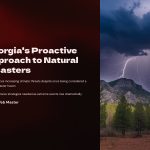 Georgia, once considered a haven from severe natural disasters, is now facing increasing threats due to climate change. The state has experienced a significant rise in natural disasters, including hurricanes, floods, droughts, and wildfires. This shift has prompted Georgia to adopt comprehensive strategies to mitigate risks and enhance resilience. This article delves into Georgia’s multifaceted approach to natural disaster preparedness and response.
Georgia, once considered a haven from severe natural disasters, is now facing increasing threats due to climate change. The state has experienced a significant rise in natural disasters, including hurricanes, floods, droughts, and wildfires. This shift has prompted Georgia to adopt comprehensive strategies to mitigate risks and enhance resilience. This article delves into Georgia’s multifaceted approach to natural disaster preparedness and response.

Understanding Georgia’s Vulnerability to Natural Disasters
Georgia’s geographical location and diverse topography make it susceptible to various natural disasters. The state has witnessed a surge in extreme weather events, with over 50 major disasters recorded between 2012 and 2022, resulting in damages exceeding $15 billion. Notably, Georgia ranks fourth nationally in terms of disaster-related losses, highlighting the urgent need for robust disaster management strategies.

Enhancing Flood Preparedness and Insurance Awareness
Flooding has emerged as a significant concern in Georgia, exacerbated by increased hurricane activity and heavy rainfall. The Georgia Office of Insurance and Safety Fire Commissioner emphasizes the importance of flood insurance, noting that even an inch of water can cause substantial property damage. Alarmingly, approximately 40% of flood insurance claims originate from areas not designated as high-risk, underscoring the necessity for widespread awareness and preparedness.

Addressing Agricultural Impacts and Economic Resilience
Georgia’s agriculture sector has been significantly affected by natural disasters, particularly unseasonal frosts and droughts. In 2023, a late frost devastated approximately 90% of the state’s peach crop, leading to substantial economic losses. The federal government responded by declaring disaster areas in 18 counties, enabling affected farmers to access emergency loans and support. These measures aim to bolster economic resilience and ensure the sustainability of Georgia’s agricultural industry.

Combating Wildfires and Promoting Forest Management
The northern regions of Georgia have experienced an uptick in wildfires, often exacerbated by prolonged drought conditions. In response, the Georgia Forestry Commission has intensified efforts to manage forest health and reduce fire risks. Initiatives include controlled burns, public education campaigns, and increased surveillance to detect and prevent arson. These proactive measures are crucial in safeguarding communities and preserving natural resources.

Community Engagement and Emergency Preparedness
Community involvement plays a pivotal role in Georgia’s disaster preparedness strategy. Local governments and organizations conduct regular emergency drills, disseminate educational materials, and establish communication networks to ensure residents are informed and ready to respond to emergencies. Emphasizing the importance of individual preparedness, authorities encourage citizens to assemble emergency kits, develop evacuation plans, and stay informed through reliable sources.

Leveraging Technology and Data for Disaster Management
Georgianatural disaster preparedness is harnessing technology to enhance its disaster response capabilities. The state employs advanced forecasting models, real-time monitoring systems, and data analytics to predict and track natural disasters. These tools enable timely alerts and informed decision-making, facilitating efficient resource allocation and emergency response. Continuous investment in technological infrastructure is vital for adapting to the evolving landscape of natural disasters.
*Capturing unauthorized images is prohibited*





